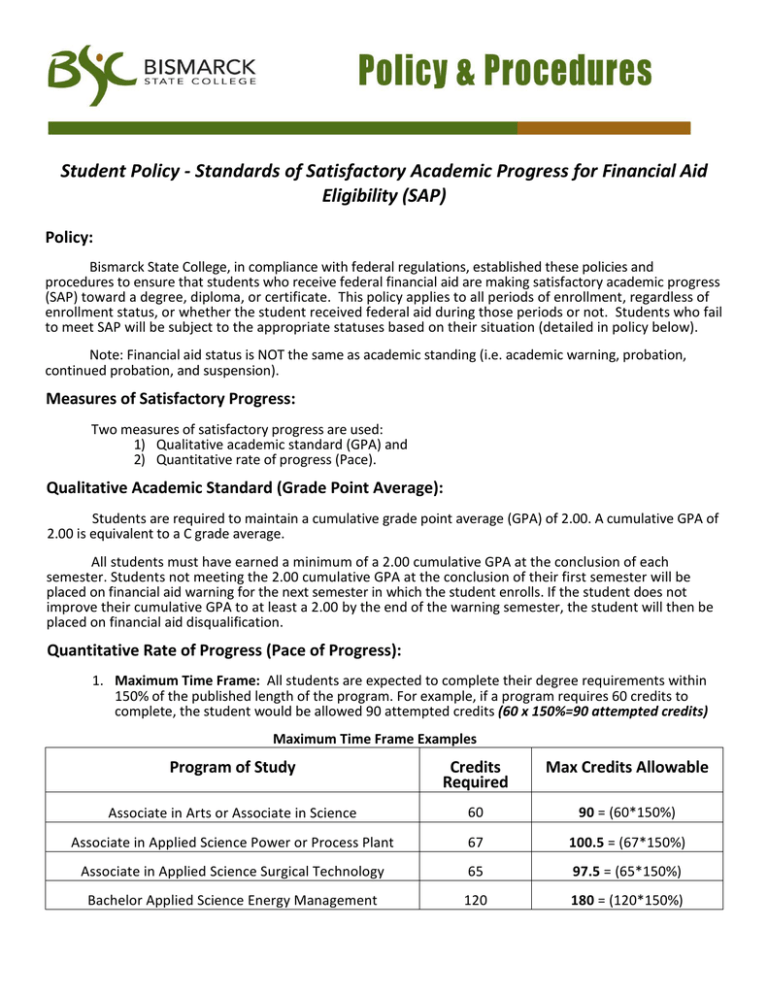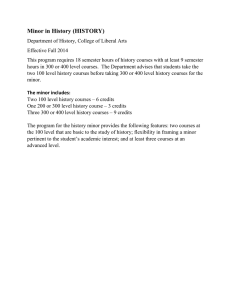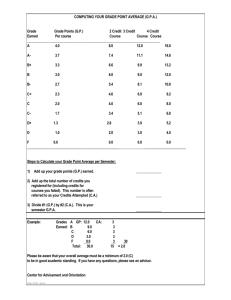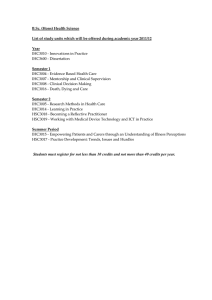Standards of Satisfactory Academic Progress for Financial Aid
advertisement

Student Policy - Standards of Satisfactory Academic Progress for Financial Aid Eligibility (SAP) Policy: Bismarck State College, in compliance with federal regulations, established these policies and procedures to ensure that students who receive federal financial aid are making satisfactory academic progress (SAP) toward a degree, diploma, or certificate. This policy applies to all periods of enrollment, regardless of enrollment status, or whether the student received federal aid during those periods or not. Students who fail to meet SAP will be subject to the appropriate statuses based on their situation (detailed in policy below). Note: Financial aid status is NOT the same as academic standing (i.e. academic warning, probation, continued probation, and suspension). Measures of Satisfactory Progress: Two measures of satisfactory progress are used: 1) Qualitative academic standard (GPA) and 2) Quantitative rate of progress (Pace). Qualitative Academic Standard (Grade Point Average): Students are required to maintain a cumulative grade point average (GPA) of 2.00. A cumulative GPA of 2.00 is equivalent to a C grade average. All students must have earned a minimum of a 2.00 cumulative GPA at the conclusion of each semester. Students not meeting the 2.00 cumulative GPA at the conclusion of their first semester will be placed on financial aid warning for the next semester in which the student enrolls. If the student does not improve their cumulative GPA to at least a 2.00 by the end of the warning semester, the student will then be placed on financial aid disqualification. Quantitative Rate of Progress (Pace of Progress): 1. Maximum Time Frame: All students are expected to complete their degree requirements within 150% of the published length of the program. For example, if a program requires 60 credits to complete, the student would be allowed 90 attempted credits (60 x 150%=90 attempted credits) Maximum Time Frame Examples Program of Study Credits Required Max Credits Allowable Associate in Arts or Associate in Science 60 90 = (60*150%) Associate in Applied Science Power or Process Plant 67 100.5 = (67*150%) Associate in Applied Science Surgical Technology 65 97.5 = (65*150%) Bachelor Applied Science Energy Management 120 180 = (120*150%) 2. Completion of Attempted Credits: Students must successfully complete two-thirds (66.667%) of the credits they attempt each semester and cumulatively complete two-thirds of attempted credits throughout their academic career. This percentage is determined by dividing the total number of successfully completed credits by the attempted credits as recorded on the student’s official transcript. Successful completion of a course means the student has earned a grade of A, B, C, D, and in some cases S. Grades of W, F, I, and U do not count as successful completion, but will count as an attempted credit. Percentage of Completion Example Semester Attempted Credits Credits Withdrawn From Completion Rate SAP Status Semester 1 12 Credits 6 Credits 50% = (6/12) Warning Semester 2 12 Credits 0 Credits 100% = (12/12) Meets Cumulative 24 Credits 6 Credits 75% = (18/24) Meets Treatment of Withdrawal Situations: Unofficial Withdrawal: Students who receive all failing grades or incomplete grades for all completed courses in any given semester are considered to have unofficially withdrawn from the college and are immediately placed on financial aid disqualification without a warning period. Federal regulations require that a refund calculation be calculated for all students receiving federal funds, unless the financial aid office staff can document an official last date of attendance beyond the 60% point in any semester. The calculation and return of funds may result in the student owing a balance to Bismarck State College and/or U.S. Department of Education. Official Withdrawal: Students who officially withdraw from all classes during any given semester could be placed on a financial aid warning or disqualification at the conclusion of the withdrawal term. These students will be reviewed on a case by case basis and individual determinations will be made based on the following criteria. 1. If this is the first time the student has officially withdrawn from all classes, and they can be reasonably expected to meet SAP by the end of the next semester of enrollment, the student will be placed on a financial aid warning. 2. If it is likely to expect that the student will not be able to meet SAP by the end of the next semester of enrollment, and/or the student is already on a SAP status (warning, information, or disqualification), the student will be placed on a financial aid disqualification. Review Procedures: All students are subject to SAP review at the conclusion of every term attended. The financial aid office will review the following. 1. Qualitative Academic Standard Review -The financial aid office will review the term and cumulative GPA of each financial aid recipient and applicant. Grades of A, B, C, D, and F will have impacts on a student’s GPA (both term and cumulative), unless it is specifically noted on the student’s official transcript that the course does not impact GPA. Grades of W, I, U, S, AU will not affect a student’s GPA, but may affect SAP for rate of progress. 2. Quantitative Rate of Progress Review - The financial aid office will review maximum time frame and completion of attempted credits for each financial aid recipient and applicant. All credit hours recorded on a student’s official transcript are subject to review and will impact rate of progress, even if they do not impact GPA. This may include transfer credits, repeated courses, remedial courses, incomplete courses, and any other courses that are assigned a credit value, but do not impact GPA. Page 2 Notification Process: Students will receive a notification of their SAP warning, information or disqualification status at the end of each semester after grades are posted. Notification will be via a letter or email sent to the student and posted on their student communications in Campus Connection. Students will also be able to view their assigned SAP status in the holds section of Campus Connection. SAP Status Definitions: Financial Aid Warning- Students are eligible to receive financial aid while on this assigned status. Students placed on financial aid warning must improve their academic performance during the next semester of enrollment. During that semester, students who are on financial aid warning must improve their cumulative GPA to at least a 2.00 and/or raise their cumulative completion of attempted credits to at least 66.667%. If the student does not meet those parameters they will be placed on financial aid disqualification. Financial Aid Information – Students are eligible to receive financial aid while on this assigned status. Students are placed on a financial aid information status if their attempted credit amount falls between 125% to 149.999% of the maximum attempted credit limit for their respective program. Students will remain on an information status until their attempted credit amount is at or exceeds the 150% measurement. Financial Aid Disqualification - Students are not eligible to receive financial aid that is affected by SAP while on this assigned status. Students will be placed on financial aid disqualification at the end of any semester if they were placed on financial aid warning during the previous semester and their cumulative GPA is still below the required minimum of a 2.00 GPA and/or their cumulative completion of attempted credits is below the required 66.667%. Students will also be placed on financial aid disqualification once their attempted credit amount is at or exceeds the 150% limit for their respective program. Types of Aid Affected by SAP: The following forms of financial aid can be subject to SAP regulations. • • • • • Federal Financial Aid (Grants, Loans, Work Study) State Financial Aid (Grants) Institutional Aid (Waivers, Scholarships) Private Loans (BND DEAL Loan) Any other sources of aid that requires SAP is met Criteria for Re-Establishing Eligibility for Financial Aid: A student placed on financial aid disqualification must re-establish eligibility for aid before they can continue to receive financial aid that is subject to SAP regulations. To do this a student may: 1. Complete one semester successfully without federal financial aid. Students must complete all attempted credits with at least a 2.0 grade point average. A student’s SAP status will then be reevaluated at the conclusion of the successfully completed term. • • If the student meets SAP at the conclusion of that term, financial aid would be reinstated. If the student is not meeting SAP at the conclusion of that term, the opportunity to file an appeal requesting reinstatement of financial aid is available. Page 3 2. If "I" (incomplete) credits are a factor in failure to maintain SAP, subsequent completion of these credits may be used to re-establish eligibility for aid. 3. Students who are placed on financial aid disqualification may complete an appeal form and submit all requested documents to the financial aid office. Students are highly encouraged to file an appeal prior to the start of any given semester. Students who file an appeal after the start of any given semester may be required to meet or visit with a financial aid administrator to determine preparedness and to answer any questions regarding preparedness. • Students must have a Free Application for Federal Student Aid (FAFSA) that is valid for the term the appeal is expected to take effect, and be admitted to BSC in a degree seeking program, before any appeal will be reviewed. • All appeals must be submitted with a signed statement from the student explaining the circumstances regarding their disqualification and a degree plan for the student’s current academic program. • Appeals based off extenuating circumstances will be dealt with on a case-by-case basis and must be submitted with documentation of the circumstance in question. Examples of extenuating circumstances include, but are not limited to the following. o Medical (illness, hospitalization, mental health issues) o Family Difficulties (death, divorce, illness or injury of immediate family member) o Other (youthful indiscretion, military deployment) • Students will be notified in writing or via email of the appeal decision of the financial aid office within 1 to 2 weeks of reaching a decision. If an appeal is approved, the student eligibility for financial aid will be reinstated on a probationary or plan of study status. Financial Aid Probation and Plan of Study – If the financial aid office approves a student’s appeal of their financial aid disqualification status, they will be placed on a financial aid probation or plan of study status. Students are eligible for financial aid while on either of these statuses. • • Financial aid probation will be granted when it is reasonable to expect that a student will be able to meet SAP within one semester and/or the student is due to graduate from their current program within one semester. Financial aid plan of study will be granted in situations where it may not be possible to meet SAP within one semester and/or a student has exceeded the maximum credit amount for their program and would otherwise not be eligible to receive financial aid for their current program. Treatment of Non-Standard Credits: Below are a few examples of non-standard credits and their impact on SAP evaluation. Repeated Coursework - All repeated coursework, including those graded with a W, I, or F, count towards the maximum attempted credit limit and the most recent grade earned counts towards the calculation of a student’s cumulative GPA. Remedial Coursework- Remedial coursework is eligible for federal aid but does not apply towards a degree or GPA calculations. Enrollment in these courses will increase the number of attempted credits and adversely affect completion rate. Page 4 Transfer Credits - All undergraduate courses, including those with grades of W, I, and F’s, are transferred in and count towards the maximum attempted credit limit. Transfer credits that are assigned a letter grade (A, B, C, D, and F) can also affect a student’s cumulative GPA. Non-Standard Credits Impact Examples: Type of credit Included in GPA Calc Included in Completion Rate Calc Included in Max Time Frame Calc Incomplete (“I” Grade) No Yes Yes Repeated Courses Yes, most recent grade Yes, each attempt Yes, each attempt Remedial Courses No Yes Yes Transfer Yes (possible exceptions) Yes Yes Withdrawn/Dropped No Yes, if “W” grade is taken Yes, if “W” grade is taken References: BSC Student Policies – Grades, Honor Points and GPA, Academic Warning, Probation, and Suspension, Course Drop, Withdrawal to Zero Credits, Drop/Withdrawal Appeals, Repeating a Course, and Transfer Credit. History of This Policy: First policy draft January 1, 1988. Revisions - August 18, 1994; December 22, 2000; March 3, 2003; June 16, 2003; May 17, 2008; reviewed by the Operations Council on July 13, 2011 and approved by the Executive Council on July 19, 2011 (changes effective July 1, 2011); reviewed by the Operations Council on November 25, 2015 and approved by the Executive Council on December 1, 2015. Page 5



